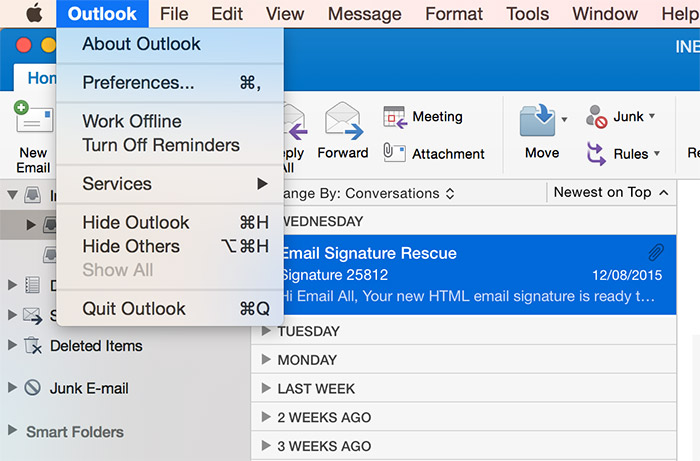

- HOW TO ADD SIGNATURE IN OUTLOOK CHROME INSTALL
- HOW TO ADD SIGNATURE IN OUTLOOK CHROME MANUAL
- HOW TO ADD SIGNATURE IN OUTLOOK CHROME CODE
- HOW TO ADD SIGNATURE IN OUTLOOK CHROME DOWNLOAD
- HOW TO ADD SIGNATURE IN OUTLOOK CHROME MAC
HOW TO ADD SIGNATURE IN OUTLOOK CHROME CODE
It also contains additional code that is shared and loaded when the add-in is used in Outlook on the web, on Windows, and on Mac. The autorunshared.js file contains the checkSignature function that handles the events from Outlook. Therefore, insert_auto_signature inserts the signature into a new appointment by directly writing to the body text of the appointment. The setSignatureAsync() API cannot be used in Outlook on the web for appointments. The autorunweb.js file contains a version of the insert_auto_signature function used specifically when running on Outlook on the web.
HOW TO ADD SIGNATURE IN OUTLOOK CHROME MAC
Outlook on the web and on Mac will load the autorunweb.html page, which then also loads autorunweb.js and autorunshared.js. When the user creates a new message or appointment, Outlook will load the files specified in the manifest to handle the OnNewMessageCompose and OnNewAppointmentOrganizer events. Handling the events and using the setSignatureAsync API The add-in handles two events that are mapped to the checkSignature() function. Outlook on Windows doesn't use the HTML page to load the runtime. The element specifies the JavaScript file instead, to load the runtime for Outlook on Windows. The following element specifies an HTML page resource ID that loads the runtime on Outlook on the web and on Mac. The manifest configures a runtime that is loaded specifically to handle event-based activation. Key parts of this sample Configure event-based activation in the manifest
HOW TO ADD SIGNATURE IN OUTLOOK CHROME MANUAL
Sideload manifest-localhost.xml in Outlook on the web, on Windows, or on Mac by following the manual instructions in the article Sideload Outlook add-ins for testing. To reroute, run the following in another command prompt.
HOW TO ADD SIGNATURE IN OUTLOOK CHROME INSTALL
npm install -global office-addin-https-reverse-proxy If you haven't installed this, run the following command. To reroute to localhost, run office-addin-https-reverse-proxy. Move the cert.pem and key.pem files to the root folder for this sample.įrom a command prompt, go to the root folder and run the following command. Use a tool such as openssl to generate a self-signed certificate that you can use for the web server. If you haven't installed this yet, run the following command. You need http-server to run the local web server. To verify if you've already installed these tools, run the commands node -v and npm -v in your terminal. Install a recent version of npm and Node.js on your computer. If you prefer to host the web server for the sample on your computer, follow these steps: The next time you create a message or appointment, you'll see the signature you selected applied by the add-in. Once you've assign the templates you want to use, choose Save. You can assign the templates to a New Mail, Reply, or Forward action. The task pane will load a page of sample templates. In the task pane fill out the fields for your signature data. This will open the task pane for the add-in. You should see a notification at the top of the message that reads: Please set your signature with the PnP sample add-in.Ĭhoose Set signatures. Open Outlook on Windows, on Mac, or in a browser. Once the add-in is loaded use the following steps to try out the functionality.
HOW TO ADD SIGNATURE IN OUTLOOK CHROME DOWNLOAD


The add-in web files are served from this repo on GitHub. You can run this sample in Outlook on Windows, on Mac (new UI in preview), or in a browser. If the user chooses to set a signature, the add-in opens the task pane for the user to continue setting their signature. When the user sends a new email message, or creates a new appointment, the add-in displays an information bar prompting the user to create a signature. In this scenario, the add-in helps the user manage their email signature, even when the task pane is not open. Use Outlook event-based activation to set the signature Note: If you do not have a Microsoft 365 subscription, you can get one for development purposes by signing up for the Microsoft 365 developer program. Set a signature for Outlook to use in messages and appointments.Use event-based activation to respond to events when the task pane is not open.If no signature is set, the add-in prompts the user to set a signature, and can then open the task pane for the user.įor documentation related to this sample, see Configure your Outlook add-in for event-based activation. The add-in can respond to events, even when the task pane is not open. This sample uses event-based activation to run an Outlook add-in when the user creates a new message or appointment. Applies to: Outlook on Windows | Outlook on the web | Outlook on Mac (new UI preview) Summary


 0 kommentar(er)
0 kommentar(er)
